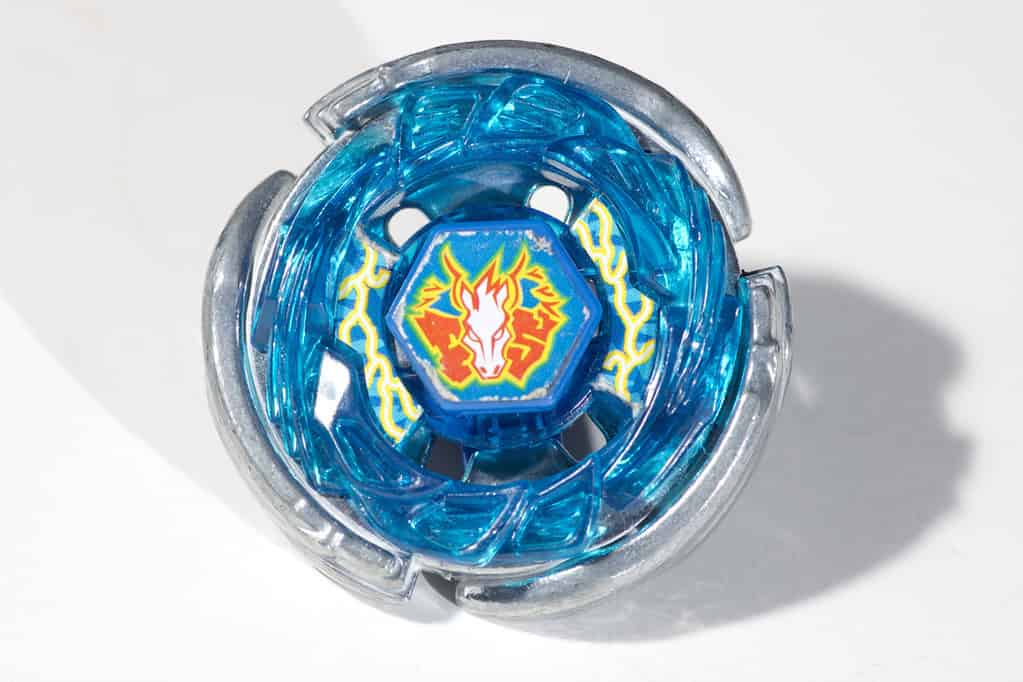Over the past two decades, Beyblade has gained a large following as the toy and anime series has evolved through different generations, introducing new characters and exciting battles. Starting as a simple spinning top game, Beyblade has become a global phenomenon, captivating fans with its dynamic battles and engaging stories. This article explores the changes in Beyblade over the years, featuring the unique characters, innovative designs, and exciting gameplay that have defined each era. Whether you’re a long-time Beyblade fan or new to the game, this journey through its evolution will reignite your passion for this thrilling and ever-evolving game.
Image Credit: https://www.flickr.com/photos/14612880@N05/6724461935
The Beyblade franchise spans five main generations: Classic, Metal Saga, Burst, Quad Drive, and X. These series follow different groups of kids as they compete with their spinning tops. The toys and shows have changed over time but keep the core idea of Beyblade battles.
Kids and adults alike enjoy Beyblade’s mix of action and strategy. The animated series add depth to the world of Beyblade. They tell stories of friendship and growth alongside the intense battles. This blend of toys and storytelling has helped Beyblade stay popular for years.
The Evolution of Beyblade: A Generational Journey
Beyblade, the thrilling spinning top game, has captured the hearts of fans worldwide with its dynamic battles and captivating storylines. Since its inception, Beyblade has evolved through distinct generations, each introducing new characters, innovative designs, and exciting gameplay mechanics.
Original Series (2001-2003)

- Beyblade (2001)
- Beyblade V-Force (2002)
- Beyblade G-Revolution (2003)
This era introduced the world to Tyson Granger and the Bladebreakers, setting the stage for epic battles against formidable opponents. The original series laid the foundation for the franchise’s enduring popularity with its focus on teamwork, friendship, and the pursuit of becoming the world’s best Beyblader.
Metal Saga (2008-2012)

- Beyblade: Metal Fusion (2008-2009)
- Beyblade: Metal Masters (2010)
- Beyblade: Metal Fury (2011-2012)
- Beyblade: Shogun Steel (2012)
The Metal Saga ushered in a new era of Beyblade, featuring metal-infused tops and a fresh cast of characters led by Gingka Hagane. These series delved deeper into the lore of Beyblade, exploring the power of the Star Fragment and the Bey Spirits.
Burst Series (2015-present)

- Beyblade Burst (2015-2016)
- Beyblade Burst Evolution (2017-2018)
- Beyblade Burst Turbo (2018-2019)
- Beyblade Burst Rise (2019-2020)
- Beyblade Burst Surge (2020-2021)
- Beyblade Burst QuadDrive (2021-2022)
- Beyblade Burst QuadStrike (2023-present)
The Burst Series revitalized the franchise with a dynamic burst mechanic that added a new layer of strategy and excitement to battles. Valt Aoi and his friends embark on thrilling adventures, facing off against powerful rivals and unlocking the secrets of the Beyblade Burst system.

| Generation | Years Active | Main Protagonist | Key Features |
|---|---|---|---|
| Original Series | 2001-2003 | Tyson Granger | Bit Beasts, customizable tops, 4D System |
| Metal Saga | 2008-2012 | Gingka Hagane | Metal wheels, Bey Spirits, Star Fragment |
| Burst Series | 2015-present | Valt Aoi | Burst mechanic, Layer System, Avatar System |
Beyblade has undeniably evolved over the years, captivating new generations of fans with its thrilling battles and engaging storylines. From the classic battles of the original series to the explosive burst mechanics of the modern era, each generation of Beyblade has left its mark on the franchise’s legacy. Whether you’re a long-time fan or a newcomer to the world of Beyblade, there’s something for everyone to enjoy in this exciting and ever-evolving universe.
Key Takeaways
- Beyblade has five main generations with unique characters and stories
- The franchise combines toys and anime to create an engaging experience
- Beyblade’s mix of action and strategy appeals to a wide age range
Evolution of Beyblade Series
Beyblade has changed a lot since it first started. The show has new stories and characters in each series. Let’s look at how Beyblade grew over time.
Original Series and V-Force
The first Beyblade show came out in 2001. It followed the Bladebreakers team. Tyson was the main character. He and his friends went to the World Championships.
V-Force came next in 2002. It brought back Tyson and the other Bladebreakers. They faced new rivals and tougher battles. The show added more drama to the beyblading matches.
Both series helped make Beyblade popular. They set up the basic rules and ideas of the Beyblade world.
G-Revolution and Metal Saga
G-Revolution aired in 2003. It was the last part of the first Beyblade story. The show had more action and bigger tournaments. Characters like Tyson grew and changed a lot.
The Metal Saga started with Metal Fusion in 2009. It had all new characters. Gingka Hagane was now the hero. The story was about stopping the Dark Nebula Organization.
Metal Masters and Metal Fury came next. They had world championships and battles against Nemesis. Shogun Steel ended the Metal Saga in 2012.
Burst Series
Beyblade Burst began in 2016. It was a fresh start for the show. The main character was Valt Aoi. The Burst beys could break apart in battle.
Burst had many seasons:
- Evolution
- Turbo
- Rise
- Surge
- QuadDrive
- QuadStrike
Each season brought new characters and beys. Aiger Akabane became an important character in later seasons. The Burst series made Beyblade popular with a new group of fans.
Cultural Impact and Continuity
Beyblade has left a lasting mark on popular culture. Its influence spans from TV shows to competitive play and collecting.
Significance in Popular Culture
Beyblade has become a cultural icon since its debut. The franchise includes anime series, manga, and toys. Each generation brings new characters and Beyblades. Storm Pegasus and Valtryek are fan favorites. The show’s themes of friendship and hard work appeal to viewers of all ages.
The series has inspired many kids to become “Legendary Bladers” like their TV heroes. Beyblade terms like “Let it Rip!” have entered everyday speech. The toys have sold millions worldwide. This success shows the strong connection between the show and its fans.
Collecting and Competitive Play
Beyblade collecting is a big part of the hobby. Fans seek rare and limited edition tops. Some collect every version of their favorite Bey. Others focus on certain types like Attack or Right Spin Beys.
Competitive play is at the heart of Beyblade culture. Local tournaments happen in many countries. There are even national and European leagues. Players test their skills and strategies against others. They use different combos of parts to create the best Bey.
Takara Tomy, the maker of Beyblade, supports official events. These bring together fans from around the world. The mix of skill, strategy, and luck in battles keeps the game exciting for all.
Frequently Asked Questions
Beyblade has several series and generations. Each one brings new characters and spinning tops. Here’s what fans often want to know about the franchise’s timeline and evolution.
What is the chronological order of the Beyblade series?
The Beyblade series starts with the original Beyblade. It’s followed by V-Force and G-Revolution. Next comes Metal Fusion and its sequels. The latest is Beyblade Burst.
How many Beyblade series are there, and what distinguishes each generation?
There are five main Beyblade generations. Each has its own characters and Beyblade designs. The original used plastic tops. Metal Fight had metal parts. Burst tops can break apart during battles.
Can you list all the Beyblade series in the order they were released?
The Beyblade series order is: Beyblade, V-Force, G-Revolution, Metal Fusion, Metal Masters, Metal Fury, Shogun Steel, and Burst. Each series builds on the last with new stories and Beyblades.
Which Beyblade series should I start with as a newcomer to the franchise?
Newcomers can start with the original Beyblade series. It sets up the story and rules. The Burst series is also good for new fans. It has modern animation and is easy to follow.
What are the different generations of Beyblade, and how do they evolve?
Beyblade has had five generations. They are Bakuten Shoot (original), Metal Fight, Beywheelz, Beyraiderz, and Burst. Each generation brings new tech and battle styles to the spinning tops.
In what order should the Beyblade Metal series be watched?
The Metal series goes: Metal Fusion, Metal Masters, then Metal Fury. Shogun Steel comes last. This order follows the story and shows how the Beyblades and characters grow stronger.






